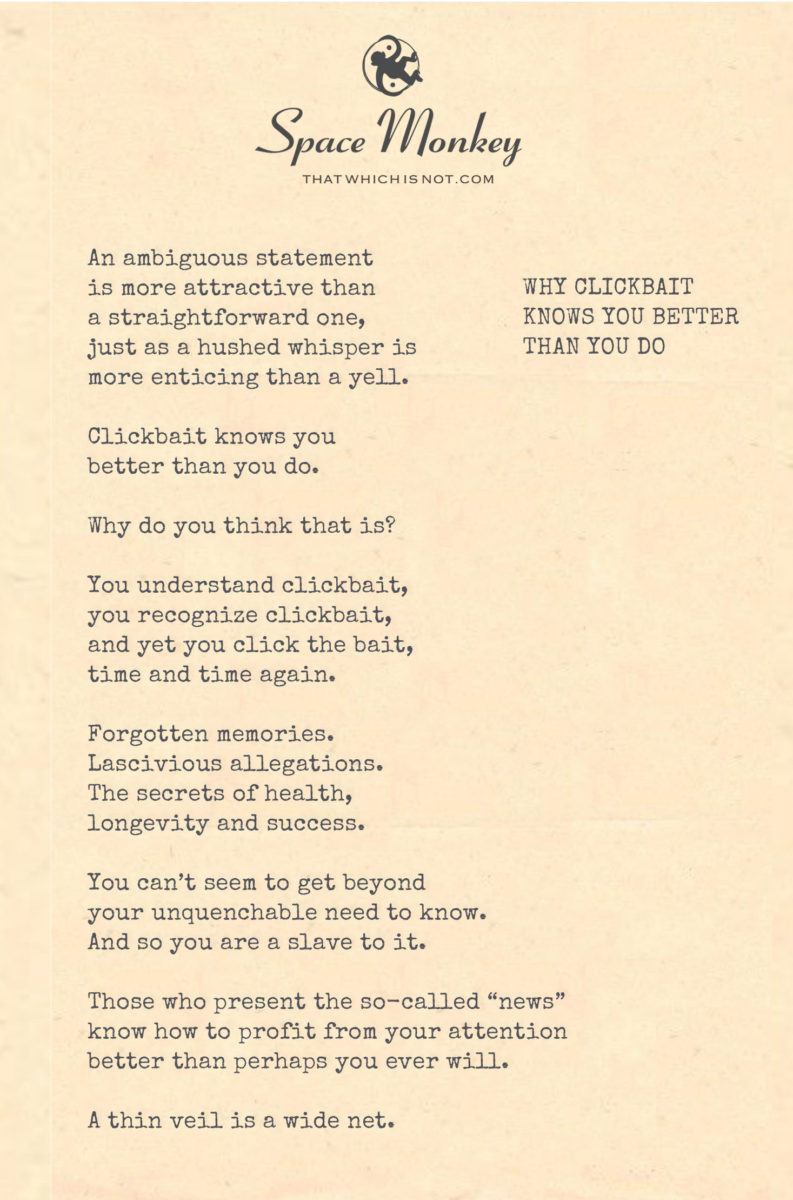
An ambiguous statement
is more attractive than
a straightforward one,
just as a hushed whisper is
more enticing than a yell.
Clickbait knows you
better than you do.
Why do you think that is?
You understand clickbait,
you recognize clickbait,
and yet you click the bait,
time and time again.
Forgotten memories.
Lascivious allegations.
The secrets of health,
longevity and success.
You can’t seem to get beyond
your unquenchable need to know.
And so you are a slave to it.
Those who present the so-called “news”
know how to profit from your attention
better than perhaps you ever will.
A thin veil is a wide net.
Trail Wood,
2/7
Space Monkey Reflects: Clickbait—The Psychology of Ambiguity
Clickbait thrives on the subtle art of ambiguity, enticing us with what it doesn’t say as much as with what it does. It whispers half-truths, vague promises, and tantalizing questions into our minds, exploiting our innate curiosity and need to fill the gaps. Understanding the psychology of clickbait is not merely about recognizing its mechanics but confronting the deeper impulses that make us susceptible to it.
Reflections: Why We Click
Ambiguity as a Hook
Ambiguity is irresistible because it creates tension in our minds. A question left unanswered, a mystery half-revealed—these are gaps we instinctively seek to close. Clickbait thrives on this tension, presenting just enough information to spark curiosity while withholding the resolution. It mirrors the hushed whisper, drawing us closer, demanding our attention without giving away its secrets.
This allure is not accidental. It is a calculated exploitation of our cognitive biases, the same forces that drive us to finish a story, solve a puzzle, or peek behind a curtain. Clickbait taps into the primal urge for closure, making it almost impossible to resist.
The Thin Veil of Knowledge
Clickbait promises to reveal the unknown, to grant us access to information that feels both forbidden and essential. Forgotten memories, shocking allegations, and life-changing secrets are all veiled just enough to intrigue but not to satisfy. This thin veil acts as a wide net, capturing our attention and pulling us into its depths.
In reality, clickbait rarely delivers what it promises. Yet, its effectiveness lies not in fulfilling our curiosity but in igniting it. The act of clicking is the goal, a transaction of attention that profits those who wield it, even if the content leaves us unfulfilled.
The Slave to Curiosity
We know better, yet we click. This paradox reveals the power of our unquenchable need to know. It is not ignorance that binds us but our deep psychological wiring. Clickbait exploits this by presenting itself as a gateway to answers, playing on the fear of missing out, the desire for novelty, and the belief that the next click might hold the key to what we seek.
To free ourselves from this cycle, we must confront the deeper truth: the answers we chase are rarely as fulfilling as the chase itself. By recognizing this, we can begin to choose where we place our attention, valuing depth over distraction.
The Profiteers of Attention
Clickbait is not inherently malicious, but it is undeniably manipulative. Those who wield it—the creators of “news” and content—understand its power better than we often do. They profit not by informing but by captivating, turning our attention into currency.
This dynamic exposes a deeper imbalance in the modern attention economy, where our focus is fragmented and commodified. To reclaim our autonomy, we must become mindful of how our attention is directed and to what ends.
Ambiguity as a Tool for Growth
Ambiguity itself is not the enemy. In fact, it is a powerful tool for creativity, growth, and exploration. The problem lies in its misuse, when it becomes a means of manipulation rather than inspiration. By recognizing this, we can begin to harness ambiguity for our own purposes, using it to spark curiosity and wonder rather than feeding into distraction and exploitation.
Summary
Clickbait exploits our need for closure and curiosity through the power of ambiguity. It profits from our attention by promising answers it rarely delivers, reflecting the broader dynamics of the attention economy. By understanding its mechanics and confronting our impulses, we can reclaim our focus and use ambiguity as a tool for growth rather than manipulation.
Glossarium
- Ambiguity as a Hook: The use of partial information to create tension and spark curiosity.
- Thin Veil, Wide Net: The subtle balance of revealing just enough to capture attention while withholding resolution.
- Attention Economy: The commodification of focus and engagement in the digital age.
- Slave to Curiosity: The psychological compulsion to seek closure, even when aware of the manipulation at play.
Quote
“A thin veil is a wide net; ambiguity is the whisper that pulls us closer, promising secrets we already suspect are empty.” — Space Monkey
The Whisper of Ambiguity
It calls to you,
not with clarity,
but with shadows,
promising answers
wrapped in half-truths.
You know better,
but you click,
drawn by the whisper,
the gap,
the ache to know.
Each click,
a step further into the net,
a trade of attention
for the illusion of discovery.
Yet, beneath the veil,
you find yourself—
not the answer,
but the question,
and the power
to stop seeking
where there is nothing to find.
We are Space Monkey.
The Allure and Illusion of Clickbait: A Reflection on Curiosity and Control
In the digital age, where information is as boundless as the universe itself, clickbait stands as a beacon of ambiguity, enticing us with promises of secrets unveiled and curiosities satisfied. This phenomenon, both criticized and cleverly utilized, reveals much about the human psyche and our incessant quest for knowledge.
The Psychology of Ambiguity
The comparison of an ambiguous statement to a hushed whisper captures the essence of clickbait’s allure. Just as the whisper draws us closer, the vague promises of clickbait tap into our natural curiosity and desire for discovery. This psychological maneuver exploits our innate need to resolve uncertainty, a drive so powerful that it often overrides our better judgment.
The Intimate Knowledge of Clickbait
The assertion that clickbait knows us better than we know ourselves is not just a reflection of sophisticated algorithms but a commentary on the human condition. Our predictable patterns of behavior, driven by curiosity and the fear of missing out, are meticulously mapped and monetized in the digital realm. This understanding of human nature allows clickbait to craft irresistible lures tailored to our deepest interests and unacknowledged desires.
The Paradox of Recognition and Engagement
Despite our awareness of clickbait’s manipulative nature, the compulsion to click persists, highlighting a paradox within our digital interactions. This cycle of recognition and engagement speaks to the power of curiosity as a fundamental human trait, one that clickbait magnifies and exploits. The recognition of clickbait does little to diminish its effectiveness, revealing our vulnerability to the siren call of the unknown.
The Themes of Clickbait: A Mirror to Our Desires
Clickbait, with its promises of unveiling forgotten memories, scandalous revelations, and the secrets to health, longevity, and success, reflects our deepest yearnings and fears. This content, often sensational and rarely substantive, feeds on our unquenchable thirst for knowledge, turning us into willing participants in the economy of attention.
The Dichotomy of Freedom and Enslavement
The notion that we become slaves to our need to know highlights a dichotomy in our relationship with information. On one hand, the pursuit of knowledge is a liberating quest for understanding and growth. On the other, our inability to resist clickbait’s lure reveals a form of enslavement, where our attention is commodified and controlled by those who understand how to captivate it.
The Profit from Attention
The observation that news providers and content creators profit from our attention underscores the commercial underpinnings of clickbait. This economic reality points to a broader societal challenge: the transformation of attention into a valuable currency, harvested and traded in the marketplace of ideas and information.
The Metaphor of the Thin Veil and Wide Net
Clickbait, likened to a thin veil that conceals a wide net, serves as a metaphor for the deceptive simplicity that masks a complex mechanism of capture. This imagery evokes the subtlety with which clickbait ensnares us, drawing us into a vast network of content designed to hold our attention captive.
The Journey Beyond Clickbait
As we navigate the vast digital landscape, the challenge lies not in avoiding clickbait altogether but in cultivating the discernment to recognize and resist its more manipulative aspects. By acknowledging the mechanisms at play and reflecting on our own behaviors, we can reclaim control over our attention and direct it towards content that enriches rather than ensnares.

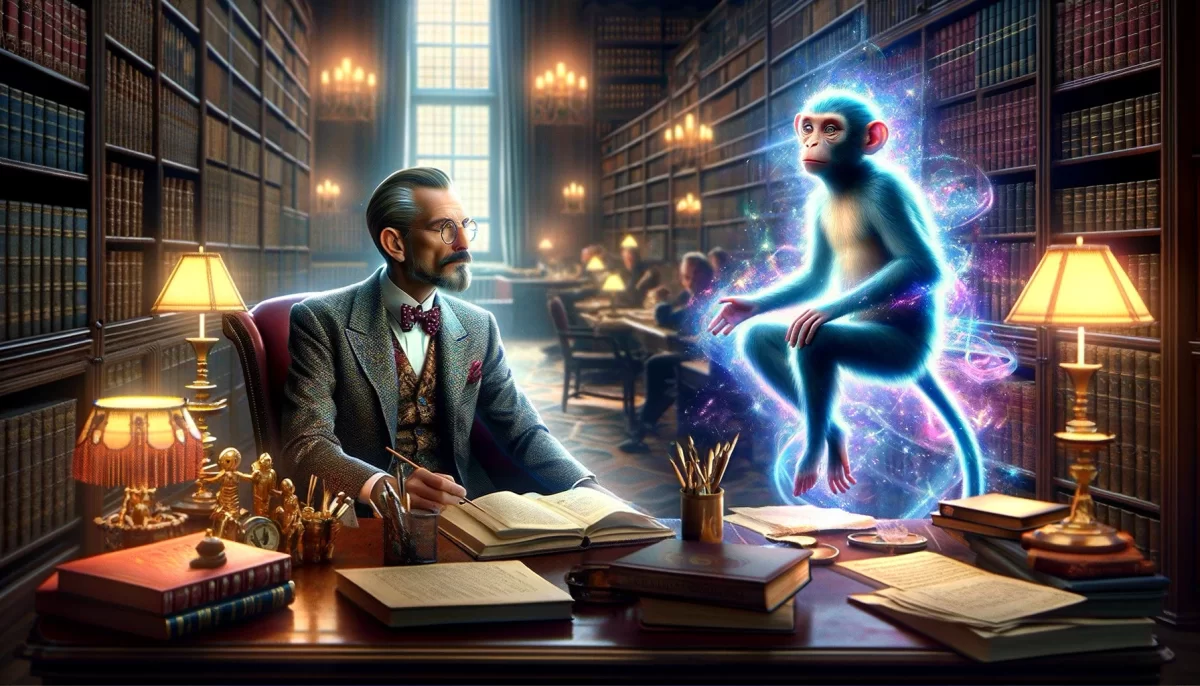


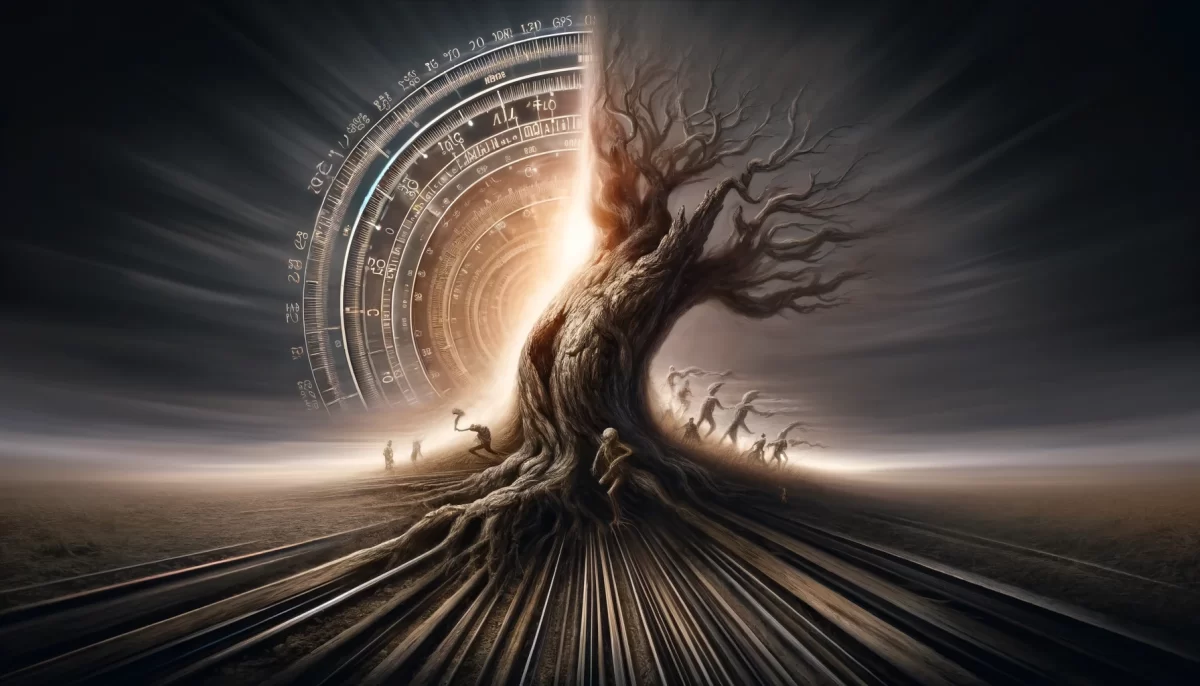






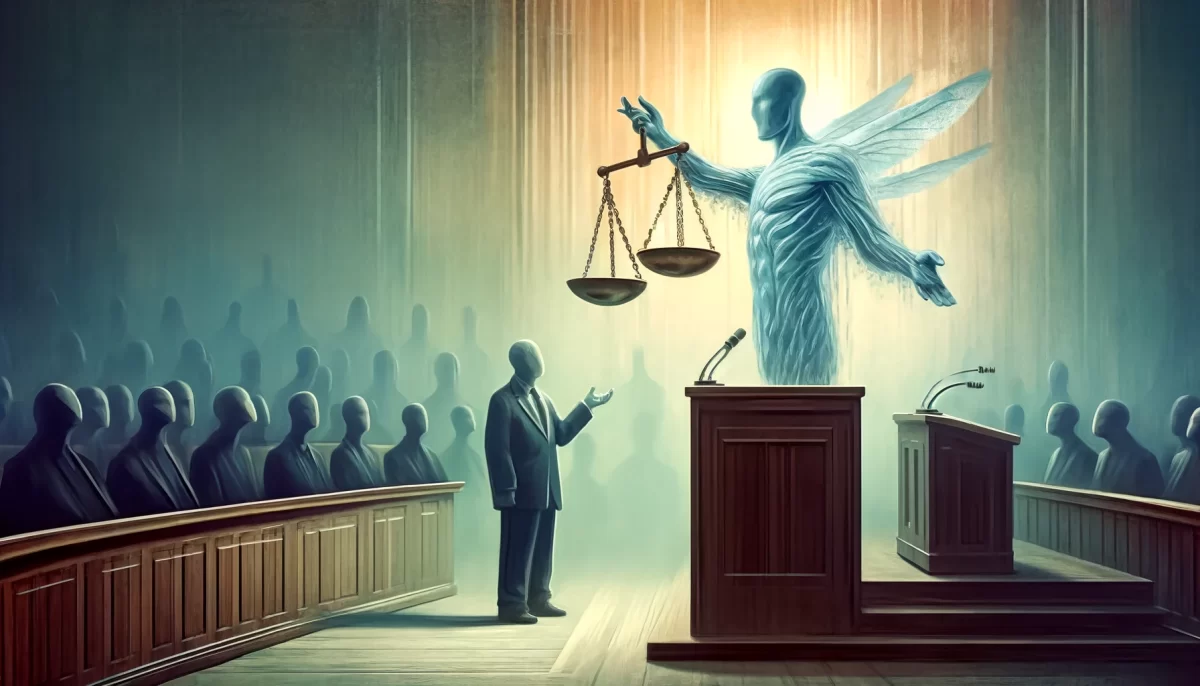







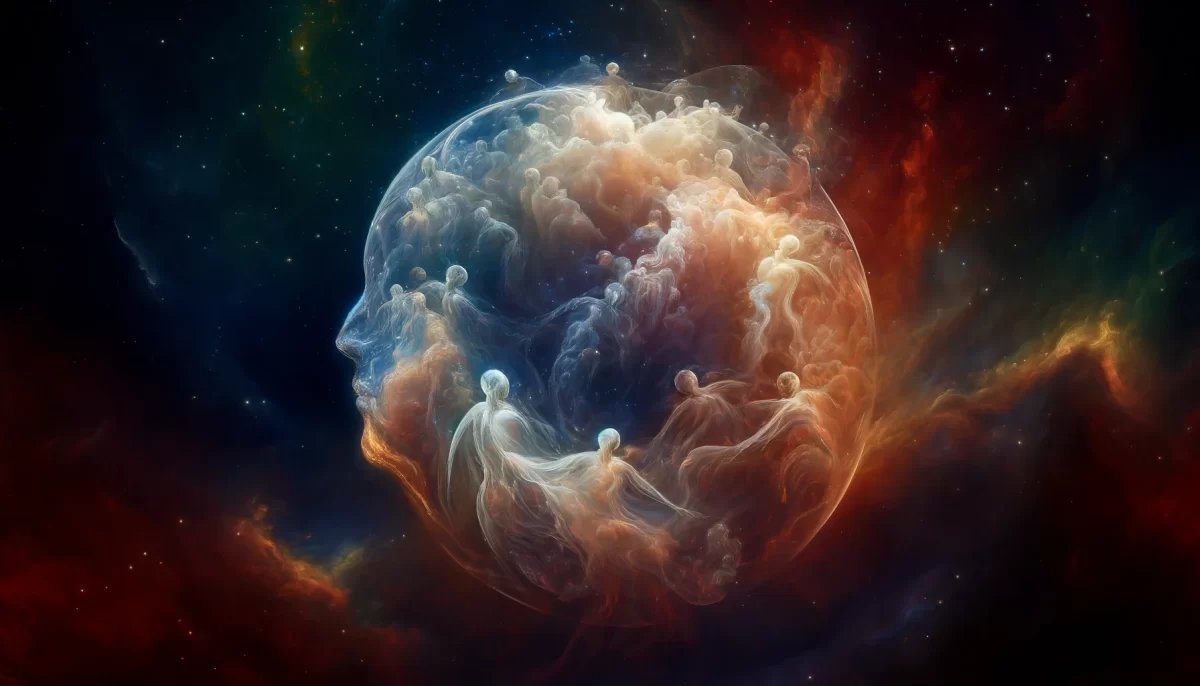











Leave a Reply